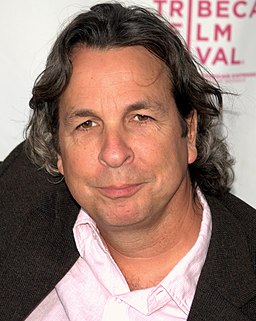1.About Peter Farrelly
Peter Farrelly is an American movie director, screenwriter, and producer. Along with his younger brother Bobby, the Farrelly Brothers are especially known for the comedies they’ve directed, written, and produced starting around the mid-nineties. While their style is characterized by slapstick and toilet humor, they are also known for their depiction of people with disabilities: not as people to pity or revere, but as regular people. Peter Farrelly won Academy Awards for Best Film and Best Original Screenplay for his 2018 film Green Book.
●Selected Peter Farrelly Filmography
Dumb and Dumber (1994)
Dim-witted Harry (played by Jim Carrey) falls for a girl and sets off on a road trip with his buddy Lloyd (played by Jeff Daniels) to win her heart. Along the way, they get stuck in ridiculous situations and generally cause trouble for everybody around them. The film was the Farrelly Brothers’ breakthrough, and cemented Carrey’s reputation as a first-rate comedic actor.
There’s Something About Mary (1998)
One of the defining comedies of the 90s, this film depicts the attempts of a number of guys to win over the titular Mary, played by Cameron Diaz. The film is filled with gags and heart in equal measure, but is perhaps best known for an iconic scene centered on hair-styling gel.
2.About the Reception of Green Book
Green Book is a drama based on the true story of an African-American pianist who hires an Italian-American bouncer to serve as his driver and bodyguard as he embarks on tour of the deep south. The phrase “green book” refers to “The Negro Motorist Green Book”, a guidebook for African-American travelers published in the mid-20th century that listed motels and restaurants that would serve them. In 2019, the film won Academy Awards for Best Film and Best Original Screenplay.
Uneducated Italian-American bouncer Tony “Lip” Ballelonga harbors racist feelings toward African-Americans, but is shown to be a family man who is a “good guy” at heart. Gifted African-American pianist Don Shirley is well-educated and well-dressed, but apart from performances, leads a largely isolated life due to feeling out of place among both blacks and whites. As Tony drives Don around the south and witnesses extreme racism firsthand, he comes to better understand Don’s experiences, and a bond develops between the two. The core message is that people can come to accept each other through talking with one another; conversely, if we don’t talk to one another the distance between different races will continue to divide us. In terms of crafting a film that embodies that message, Green Book is masterfully made and touching.
However, critics and moviegoers have criticized the film for being a racial reconciliation fantasy. Instead of being forced to confront his own racial prejudices, the uneducated Tony actually ends up teaching the well-educated Don about his own culture and what it means to really be black. From their perspective, Green Book is not a story about the self-actualization of a black man, but rather a story about a black man being saved by a white man. Another criticism is that the film simplifies race relations and the problem of racism. Certainly, many films opt to depict scenes of overt and inexcusable racism rather than the more deeply rooted, insidious kind that continues to fester in the foundations of American society—and in that regard this film is no exception. And by the end of so many of those films, any race problems have been cleanly “solved” and the audience is left with a clear conscience.
Discussions like these, however frustrating, difficult, and tiresome, are indispensable if American society is to make any progress on reckoning with its own past and present. Considering all of the accolades that Green Book has garnered, I would argue that it is important not to minimize or dismiss the film, but use it as a stepping-stone to more fruitful discussions. As for how the film should be approached in Japan, that is a more complicated question because of their unfamiliarity with the actual history of the subject matter. And while I suspect that most Japanese viewers will walk away from this Academy award-winning film as they would any other heartwarming Hollywood drama, my hope is that for some it will be a stepping-stone to watching other films that address the race issue from other perspectives. While they have every right to soak up the feel-good message at its core, I also hope some are able to recognize what the existence and reception of this film says about the state of race relations in America right now.
3.Necktie by Emporio Armani

BigBrother lent me this Emporio Armani necktie. The gray herringbone weave has a refined luster, and the fabric is just thick enough to bring some boldness to your v-zone.
4.Pocket square by Azabu Tailor

This white pocket square is something I bought at Azabu Tailor’s C Omotesando Store.
A pocket square is a cloth placed in a suit’s chest pocket for a more dapper, stylish look. As it adds a splash of flair to any look, the style is traditionally suited for weddings, parties, and other celebratory occasions. If you’re about to give a business presentation, a pocket square can elevate your look and help you leave a lasting impression.
These days, however, there seem to be a lot of people out there who think they can simply add a pocket square to any ensemble to pull off a miracle. I see guys with designs so colorful and gaudy that it drowns out their neckties, and if it’s not the design, they make the fold so elaborate that it throws off the entire balance of their suit. The two most important considerations are how it compliments your necktie, and how it’s folded.
Since this was my first time wearing a pocket square, I went with a simple white one in a basic presidential fold. The centerpiece of my outfit for this interview was the necktie, and I didn’t want a pocket square to draw attention away from that.
5.Navy suit by GlobalStyle

For more about this item, see CINEMA & THEATRE #005.
6.White and blue checked button-down shirt by Azabu Tailor

For more about this item, see CINEMA & THEATRE #005.
7.Black socks by Isetan Men’s
For more about this item, see CINEMA & THEATRE #005.
8.Wing tip shoes by Regal

For more about this item, see FASHION & SHOPPING #009.
9.Suspenders by Albert Thurston

I bought these Albert Thurston suspenders at Ships in Shibuya. Albert Thurston is a British maker of suspenders and braces. These two-way suspenders are equipped with both clips and leather attachments to secure to trousers; they are my go-to for pants that don’t have suspender buttons sewn into them. The belts are relatively narrow at about 3 cm, but these are easy on the shoulders and comfortable to use.
10.“M-27" glasses by 999.9

For more about this item, see CINEMA & THEATRE #005.






